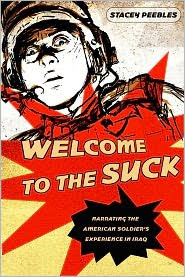 Stacey Peebles’ 2011 Welcome to the Suck: Narrating the American Soldier’s Experience in Iraq only discusses one book of poetry—Brian Turner’s Here, Bullet (and treats it as if it were memoir rather than verse)—and one dramatic film—In the Valley of Elah–but it should engage anyone interested in the art, film, and literature about our contemporary wars. A study of the first wave of writing and film by and about contemporary veterans, Welcome to the Suck has much to say about the Iraq War, the men and women who fought it, the nation who sent them off to fight, and the way the war is represented in text and film.
Stacey Peebles’ 2011 Welcome to the Suck: Narrating the American Soldier’s Experience in Iraq only discusses one book of poetry—Brian Turner’s Here, Bullet (and treats it as if it were memoir rather than verse)—and one dramatic film—In the Valley of Elah–but it should engage anyone interested in the art, film, and literature about our contemporary wars. A study of the first wave of writing and film by and about contemporary veterans, Welcome to the Suck has much to say about the Iraq War, the men and women who fought it, the nation who sent them off to fight, and the way the war is represented in text and film.
Peebles’ thesis is that that memoirs, poetry, and movies by and about Iraq veterans document veteran struggles to reconcile military and civilian identities. The authors and artists she studies join the military willingly, but subsequently find themselves at odds with martial culture and ideals. Formed by their contemporary cultural context–rapidly changing gender norms, pop cultural saturation, and digital media possibility—they enlist confident they can handle the worst they might see. But military life, and more specifically the experience of war, overwhelms them. Still proud of their service and eager to remember positive aspects of it, their nostalgic fondness rests uneasily alongside messed-up minds and damaged bodies. The texts they write and the movies made about them record this confused and fragmented sense of self.
In chapter one, “Lines of Sight: Watching War in Jarhead and My War: Killing Time in Iraq,” Peebles discusses two early war memoirs, Anthony Swofford’s 2003 Jarhead and Colby Buzzell’s 2005 My War: Killing Time in Iraq. Each describes how their authors’ fascination with pop culture, especially movies about Vietnam, influences both their time in service and how they write about it later. The chapter also dissects how Iraq differed from Vietnam, how the perspective of contemporary soldiers was shaped by their times and sense of history, and how new technologies—such as the DVD and the blog–impacted the fighting of the war tactically and personally.
In chapter two, “Making a Military Man: Iraq, Gender, and the Failure of the Masculine Collective,” Peebles explores three memoirs that illustrate how modern soldier identities clash with traditional military stereotypes and the concept of the military as a “masculine collective.” Peebles first analyzes Joel Turnipseed’s 2003 memoir Baghdad Express, in which Turnipseed presents himself as a philosopher-aesthete among the Marines with whom he deploys. Next, Peebles examines Nathaniel Fink’s 2005 memoir One Bullet Away: The Making of a Marine Officer, in which Fink describes his ultimately failed attempt to project “hardness” to the soldiers under him. Finally, Peebles looks at Kayla Williams’ 2005 memoir Love My Rifle More Than You, in which Williams recounts her efforts to gain acceptance in the male-dominated units with whom she serves in Iraq.
In chapter three, “Consuming the Other: Blinding Absence in The Last True Story I’ll Ever Tell and Here, Bullet,” Peebles compares the attitudes taken toward Iraqis in two works, John Crawford’s memoir The Last True Story I’ll Ever Tell (2005) and Brian Turner’s volume of poetry Here, Bullet (2005). Where Crawford is “consumed” by hatred and disgust, Turner is filled with empathy and curiosity about Iraqis as people and for their history and culture. While the problems with Crawford’s point-of-view are obvious, Peebles also suggests that Turner’s surfeit of empathy also presents difficulty: it complicates his role as a soldier and as a literary tactic risks aestheticizing the enemy “Other.”
Chapter four, “On U.S.: Combat Trauma on Film in Alive Day Memories and In the Valley of Elah,” examines two 2007 films: the HBO documentary Alive Day Memories: Home from Iraq and Paul Haggis’s feature film In the Valley of Elah. Peebles suggests that both films—each about the physical and mental wounds endured by veterans—represent movie-making and storytelling as “sophisticated [narrative] prostheses” that complement therapeutic, medical, and mechanical recovery aids. While promising much, filmmaking also suffers the same limits as, say, a prosthetic leg or trauma medication—while trying to generate a return to “wholeness” that is probably not really attainable, they also exacerbate and extenuate the sense of loss and disjunction felt by the war’s casualties.
At the end of each chapter, Peebles renders a brief look at an Iraqi blog, text, or film that supplements the discussion of the American cultural artifacts under examination, and in her conclusion she compares The Hurt Locker to Vietnam movies such as Full Metal Jacket, The Deer Hunter, and Apocalypse Now. Welcome to the Suck is published by a university press and features references to literary criticism heavyweights such as Judith Butler and Jurgen Habermas. But Peebles writes lucidly and economically, and the book is as organized as a five-paragraph mission order. Without describing specific battles and barely mentioning politics, Peebles delights the eager reader with the acuity and freshness of her insights. An academic text that is accessible to the interested general audience, Welcome to the Suck sets a high bar for the critical studies that are sure to follow.
Stacey Peebles’ Welcome to the Suck: Narrating the American Soldier’s Experience in Iraq. Cornell University Press, 2011.
